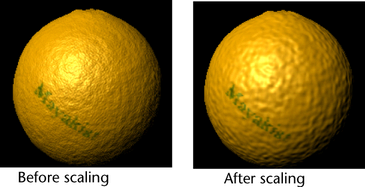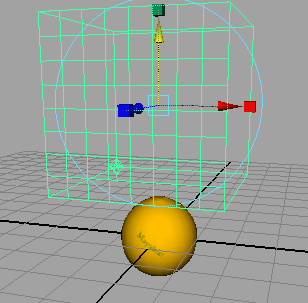The bump texture is too crater-like to be a convincing orange. The bumps are too numerous and too deep. A quick way to fix this problem is to scale up the entire texture.
To interactively position a 3D texture
This node controls the 3D texture’s position, scale, and rotation. The visual display of this node is a large cube that surrounds the sphere in the scene view. This is the texture placement cube.


Now when you render, the bumps on the surface appear wider and smoother, like the bumps on an orange skin. For example, the bumps in the area surrounding the highlight do not appear to be as deep as they were before you scaled the texture.

Scaling a texture placement cube is a common way to tune the texture’s display. Scaling does not actually change the pattern, but enlarges or shrinks it relative to the surface.

If you have tumbled the camera for a different view of the orange or the texture placement cube, ensure you reposition the camera so that the orange’s Mayakist logo is visible before rendering again. Otherwise, the rendered image will appear incorrect.
In the rendered image, notice that the bumps still remain on the sphere. Objects do not need to be within the texture placement cube, because it represents an imaginary texture volume, which is infinite.
However, movement of the texture placement cube does shift the surface texture pattern. The difference is hard to notice on a uniform texture like Brownian. Transforming the cube would be more noticeable with a texture such as Marble, where the veins within the pattern would be repositioned.
Movement of the object itself also shifts the surface texture. For example, if you were to animate the orange rolling and then render an image sequence, the texture would shift each frame rather than roll with the surface. To prevent this undesirable effect, you need to make sure that the texture moves in the same way the object moves. One way to do this is to parent the texture placement cube (also called the place3dTexture node) to the object. For more information on parenting, refer to the Maya Help.